I initially planned on writing this piece in response to Greg Pease’s November column in Pipes Magazine. The last question that Greg answered there was about what type of pipe Frosty the Snowman and Santa Claus smoke.
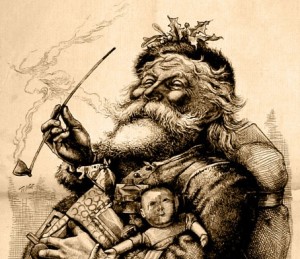 I was enchanted by the thought. As Mr. Pease says, Frosty is easy, just by looking at any picture of him or listening to the classic song: he smokes a corncob, like so many other people did back in 1950. Santa (Father Christmas or Saint Nicholas), on the other hand, smokes a little bit of everything. Sometimes he smokes a clay pipe, while other times he smokes a Prussian-style porcelain pipe, a figural meerschaum, a simple briar, or sometimes even a humble corncob.
I was enchanted by the thought. As Mr. Pease says, Frosty is easy, just by looking at any picture of him or listening to the classic song: he smokes a corncob, like so many other people did back in 1950. Santa (Father Christmas or Saint Nicholas), on the other hand, smokes a little bit of everything. Sometimes he smokes a clay pipe, while other times he smokes a Prussian-style porcelain pipe, a figural meerschaum, a simple briar, or sometimes even a humble corncob.
For most people, especially those who know any of the history of the fantastical figure of Santa Claus, the pipe is simply one of the many qualities that makes Santa such an enchanting figure: he hearkens back to older times, brings us simple pleasures, and reminds us a little bit of that grandfather who would bring us a trinket or present every time he came to visit. He is jolly, full of laughter, and something that we love the image of, even those of us who are deluded enough to think Santa doesn’t exist (heathens!).
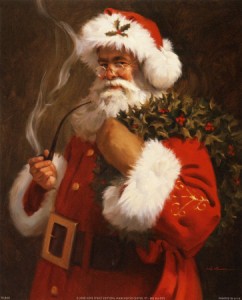 I had also planned on saving this post until closer to Christmas. Despite this, I wanted to get my supplies in order, so I started searching for old drawings and pictures. I found many pictures that brought smiles to my face and made me feel like a child once again. They also made me want a meerschaum pipe carved in Santa’s likeness.
I had also planned on saving this post until closer to Christmas. Despite this, I wanted to get my supplies in order, so I started searching for old drawings and pictures. I found many pictures that brought smiles to my face and made me feel like a child once again. They also made me want a meerschaum pipe carved in Santa’s likeness.
While searching for these pictures, however, I found a website that changed everything. There was an article from the Guardian in the UK entitled, “Santa’s pipe put out in new edition of children’s classic”. Wait, what?
Yes, that’s right, ladies and gentlemen. According to this article, Clement C. Moore’s classic, “A Visit From St. Nicholas” — the poem with the famous line, “‘Twas the night before Christmas” — is being released in a new edition, but, this time, it will be missing a couple of lines. Those lines include “The stump of a pipe he held in his teeth, / And the smoke, it encircled his head like a wreath.” Not only that, the illustration of St. Nicholas was redrawn to censor out the pipe and the smoke.
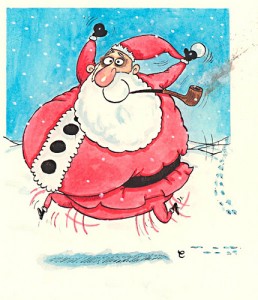 Pamela McColl, the publisher and censor of this new version, explains her justification. “I have edited out a few words and lines that reference Santa smoking and removed the cover illustration of his pipe. The omission of these few words do not change the material intent of the author nor do they infringe on the reader’s understanding or enjoyment of this historically-rich story, but by removing these words we may save lives and avoid influencing new smokers,” she says. ”I think these edits outweigh other considerations. If this text is to survive another 200 years it needs to modernise and reflect today’s realities. I want children to celebrate the spirit of giving and to reflect proudly on the holiday traditions that shape their childhood, and the best way to honour Santa and this story is to make him smoke-free.”*
Pamela McColl, the publisher and censor of this new version, explains her justification. “I have edited out a few words and lines that reference Santa smoking and removed the cover illustration of his pipe. The omission of these few words do not change the material intent of the author nor do they infringe on the reader’s understanding or enjoyment of this historically-rich story, but by removing these words we may save lives and avoid influencing new smokers,” she says. ”I think these edits outweigh other considerations. If this text is to survive another 200 years it needs to modernise and reflect today’s realities. I want children to celebrate the spirit of giving and to reflect proudly on the holiday traditions that shape their childhood, and the best way to honour Santa and this story is to make him smoke-free.”*
The fact that this misled woman actually believes that this censorship has the potential to “save lives” reveals a deluded sense of grandeur, a misunderstanding of the medical literature, and an overestimation of how much credibility children give fantasy stories when they decide how they are going to live their lives. I know many a young man who was debating whether or not to take up a pipes and then thought to himself, “You know, Santa smoked a pipe, so I definitely should, too!”
She also says that “do not change the material intent of the author”. How clear it is that this woman has never had a character that she created with pen and paper forcibly altered. Let’s take another example of a famous pipe smoker: Sherlock Holmes. Is Sherlock Holmes’s pipe necessary to him being the center of detective stories? No. Would the character be fundamentally different from the original penned by Sir Arthur Conan Doyle? Yes. Much like the modern BBC version that does not smoke a pipe is clearly a different character and, I would hope, would never be suggested as a replacement for all other versions. If someone wanted to change the colors of the trees in the Mona Lisa, that person could not simply say that it was acceptable because the “material intent” was not altered.
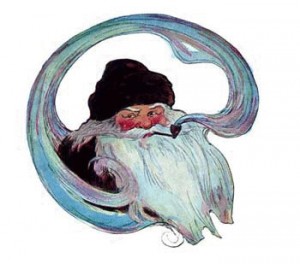 There is hope, however. The American Library Association (ALA) says that this is “an act of censorship that denies the audience access to the author’s authentic voice”. The major silver lining here is that those fighting against the removal of the pipe are not tobacco advocates or anything of the sort, but a group the wants to preserve literary history.
There is hope, however. The American Library Association (ALA) says that this is “an act of censorship that denies the audience access to the author’s authentic voice”. The major silver lining here is that those fighting against the removal of the pipe are not tobacco advocates or anything of the sort, but a group the wants to preserve literary history.
The ALA’s objections help to point out what ms McColl is really doing: attempting to change history because she doesn’t like the smell. In order to forward her admitted personal agenda of eliminated smoking, Ms. McColl doesn’t just want to change a story, but wants to eliminate part of the work of someone who produced a poem that resonates with millions of people across multiple generations.
Another area for hope is the comments section in the online Guardian article. Many bemoaned that this would no longer be the Santa that they grew up knowing and loving. Another phrased the problem with the solution beautifully: “curing dandruff with decapitation.”
One comment in particular caught my attention. This comment was responding to all of the anger in response to this censored edition: “WILL SOMEONE PLEASE THINK OF THE CHILDREN” (all-caps theirs).
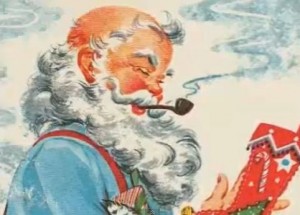 Indeed, let’s think of the children. How many children do you think have taken up smoking a pipe behind the high school because they saw Santa doing it? For that matter, I am willing to bet that there is a large amount of individuals who saw their fathers, grandfathers, or some other relative smoking a pipe, yet did not smoke themselves.
Indeed, let’s think of the children. How many children do you think have taken up smoking a pipe behind the high school because they saw Santa doing it? For that matter, I am willing to bet that there is a large amount of individuals who saw their fathers, grandfathers, or some other relative smoking a pipe, yet did not smoke themselves.
You know what? I’ve had a change of heart. I like this idea. In fact, let’s take it further! I think that leprechauns shouldn’t have pots of gold, because it encourages greed; the tooth fairy shouldn’t take teeth, because it encourages stealing; the Easter Bunny should stop handing out eggs, because eggs are full of cholesterol and have been found to cause a great deal of heart damage. (Removing tongue from cheek)
Honestly, though, I’m curious why Ms. McColl didn’t remove lines referencing Santa’s weight. After all, obesity is a serious health issue impacting our country. Oh, sure, it’s okay to eat nothing but cookies and milk, but heaven forbid Old Saint Nick smokes a pipe.
*http://www.guardian.co.uk/books/2012/oct/24/santa-pipe-new-night-before-christmas


 Subscribe to RSS feed
Subscribe to RSS feed